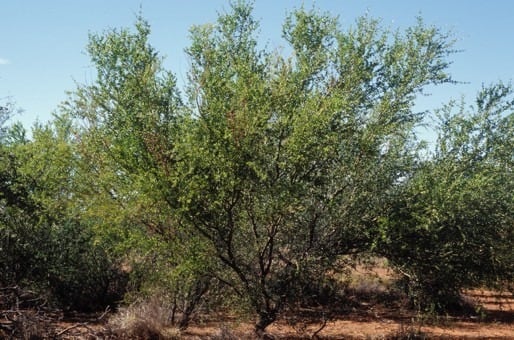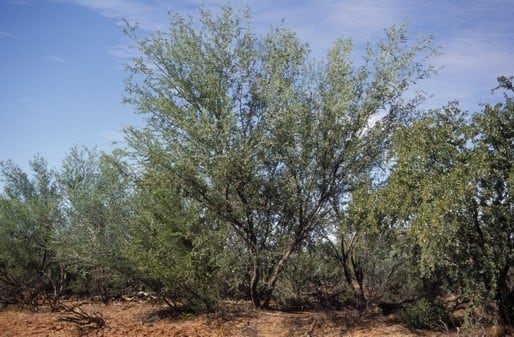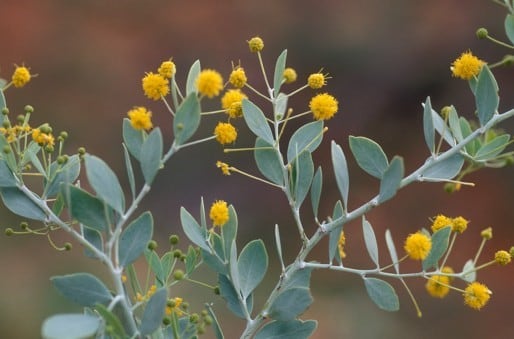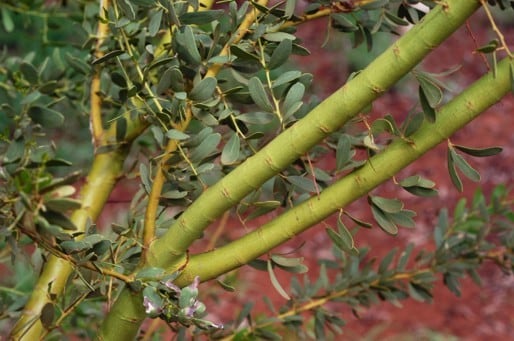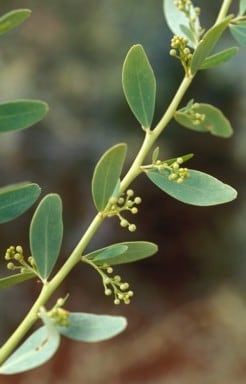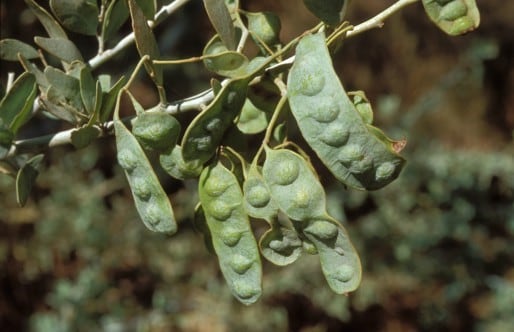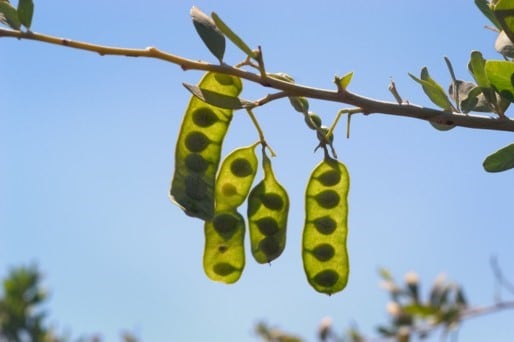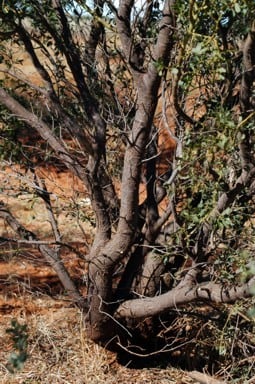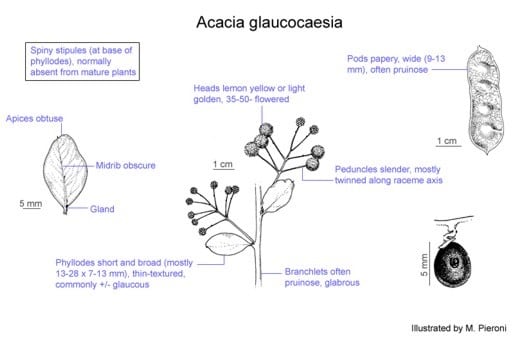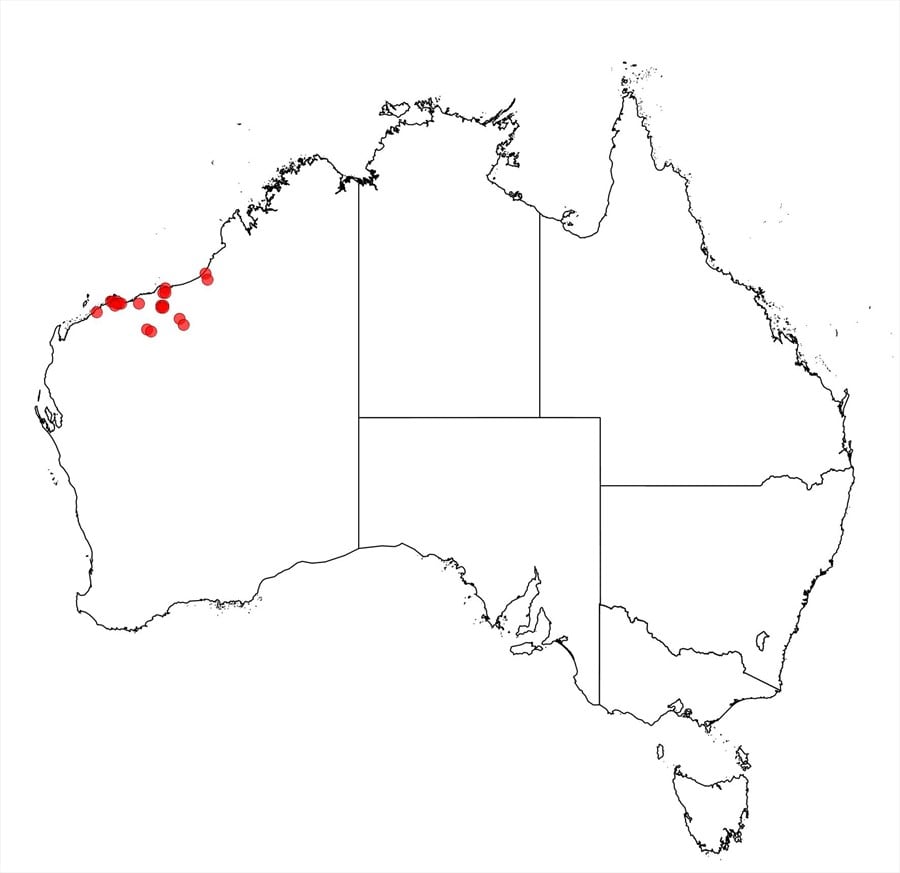Acacia glaucocaesia Domin
WATTLE
Acacias of Australia
Family
Fabaceae
Distribution
Known only from a few scattered localities in the western part of the Pilbara region mainly between the Fortescue and De Grey Rivers, including North Turtle Is., north-western W.A. A sterile specimen with persistent, spinose stipules, collected from a regrowth population at Salt Ck, between Port Hedland and Broome (B.R.Maslin 4874, PERTH), is tentatively referred to this species: see B.R.Maslin, Nuytsia 8: 298 (1992), for discussion.
Description
Glabrous shrub or tree 2–4 (–7) m high. Branchlets usually pruinose. Stipules spiny and slender (young plants), generally absent from mature plants where they are represented by minute tooth-like projections at the nodes. Phyllodes commonly elliptic to narrowly elliptic or lanceolate, 1.3–2.8 (–3.5) cm long, (5–) 7–13 (–17) mm wide, l:w = 1.5–3, thin, rounded-obtuse, commonly glaucous to sub-glaucous and lightly to moderately pruinose, rarely dark green, midrib not prominent, finely penninerved; gland 0–1 mm above the pulvinus, 0.3–0.5 mm long. Inflorescences racemose (with axes 1–6 cm long) as in A. victoriae, some simple as in A. synchronicia; peduncles mostly twinned, 7–10 (–13) mm long, slender, with caducous bract above middle; heads prolific, globular, 35–50-flowered, lemon yellow or light golden. Flowers 5-merous; sepals free. Pods narrowly oblong, to 4 cm long, 9–13 mm wide, chartaceous, pruinose. Seeds transverse, oblong to ovate, 4.5–5 mm long, slightly shiny, brown to black; funicle thick, scarcely arillate.
Phenology
Flowers July–Oct.
Habitat
Grows in sandy loam on flood plains and commonly forms almost monospecific stands.
Specimens
W.A.: Mardie Stn, C.A.Gardner 3079 (PERTH); Karratha–Port Hedland area, P.Glennon 13 (PERTH); 2.8 km W of Goldsworthy turn-off on North West Coastal Hwy, L.Thomson LXT 1183 (PERTH).
Notes
The taxonomic status of this poorly collected species is uncertain. A member of the ‘A. victoriae group’, but is perhaps better placed within A. victoriae from which it differs mainly in more flowers per head, slightly shorter and less elongate phyllodes, and stipules consistently absent from mature nodes, fide B.R.Maslin, loc. cit. Sympatric with A. synchronicia (another member of the ‘A. victoriae group’) with which it putatively hybridizes near Cleaverville (between Karratha and Roebourne). Acacia synchronicia has a more open growth habit, golden flower-heads, and thicker, commonly narrower and longer phyllodes with normally more prominent glands. Broad phyllode forms of A. synchronicia from the eastern Pilbara area are sometimes confused with A. glaucocaesia.
Non-pruinose forms of A. glaucocaesia occur in some populations, usually at a low frequency. They are characterized by lime green stems and branches, and dark green phyllodes.
FOA Reference
Data derived from Flora of Australia Volumes 11A (2001), 11B (2001) and 12 (1998), products of ABRS, ©Commonwealth of Australia
Author
Edited by B.R.Maslin
B.R.Maslin
This identification key and fact sheets are available as a mobile application:
URL: https://apps.lucidcentral.org/wattle/
© Copyright 2018. All rights reserved.
